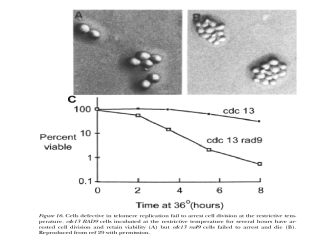 Figure 16. Cells defective in
telomere replocation fail to arrest cell division at the restrictive
temperature. cdc13 RAD9 cells incubated at the restrictive
temperature for several hours have arrested cell division and retain
viability (A) but cdc13 rad9 cells failed to arrest and die (B).
Reproduced from ref 29 with permission. |
The rad9
mutant exhibited a 20 fold increase in the rate of chromosome loss in
the absence of any extrinsic DNA damage. An explanation for the increase in
chromosome loss in checkpoint defective cells was provided by Tedís
discovery that the same mutations that rendered cells insensitive to arrest
of mitosis by radiation also rendered cells insensitive to arrest by defects
in DNA replication. This suggested that intrinsic errors in DNA replication
occurred stochastically in rare cells of the population and that the
checkpoint function was needed in those cells to assure correct repair of
the damage. The same checkpoint genes were later found by Mandy Paulovitch
to control the rate of replication over damaged DNA (30) and by Siede,
Friedberg and Friedberg to control the rate at which cells enter S phase
when they experience damage in G1 (31). |
